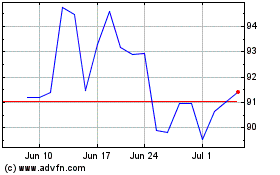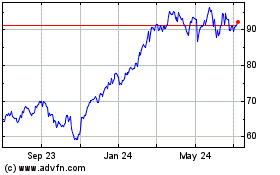By Andrew Tangel and Ted Mann
A global pact to limit planet-warming emissions is likely to
force manufacturers of air conditioners and refrigerators to
consider passing the additional cost of alternative coolants to
consumers.
Global envoys agreed on Saturday to phase out hydrofluorocarbons
from cooling appliances beginning in 2019. Meeting in Rwanda, major
emitters including the U.S., China and India agreed to aim for an
80% reduction in their use by 2045.
Alternative coolants exist to power window-unit air
conditioners, commercial chillers and household refrigerators, but
many are unapproved for use in the U.S. Some are flammable.
Manufacturers will have to convince regulators the new compounds
are safe before retooling production.
"It's not going to be easy, but we're committed to doing it,"
said Stephen Yurek, chief executive of the Air-Conditioning,
Heating, and Refrigeration Institute, a trade group.
Many companies anticipated that so-called HFCs would eventually
be banned. They have collectively spent billions of dollars
researching alternatives, Mr. Yurek said, adding that his group
supported a global framework for coolant regulations.
The U.S. Environmental Protection Agency recently set deadlines
to phase out HFCs in new appliances such as refrigerators by 2021
and in chillers by 2024. Industry groups have said those targets
would hurt business.
"Our members are rushing right now to make sure that the
alternative refrigerants are going to work, going to be safe," said
Joe McGuire, chief executive of the Association of Home Appliance
Manufacturers.
He said manufacturers want more time to harmonize guidelines
related to refrigerants as well as new expected rules mandating
greater energy efficiency. Meeting the 2021 refrigerator deadline,
instead of the 2024 date the industry proposed, could collectively
cost manufacturers an additional $230 million, he added.
"We don't want to have to do major redesigns twice within a
couple-year period," Mr. McGuire said.
An EPA spokesman said: "While there will be some costs
associated with transitioning to alternatives, we do not anticipate
that this will pose a significant burden on industry --
particularly given the many commitments they have already made to
move to climate-friendly alternatives."
Kevin Fay, executive director of the Alliance for Responsible
Atmospheric Policy, an industry group that represents chemical
companies and appliance makers, said retooling a chemical plant for
a new coolant could cost more than $200 million. But consumer
prices for appliances might eventually rise only as much as about
2%, as has been the case in previous coolant phaseouts, he
said.
The phaseout could be a boon for makers of less-polluting HFC
alternatives that are already on the market.
Honeywell International Inc. over the past few years has ramped
up production of refrigerants that emit less greenhouse gas than
HFCs.
A vice president from the company's Performance Materials &
Technologies unit, Patrick Hogan, told investors at a conference in
June that its "Solstice" line of refrigerants, aerosols and
solvents would be "a $1 billion business in the next year."
Honeywell said is was designing as many offerings as possible in
the Solstice line as "drop-ins," meaning they can be used by
appliance and vehicle manufacturers with minimal design changes,
which could help offset the higher cost of the new coolants. Some
nine million vehicles are equipped with air conditioners using
Honeywell's post-HFC refrigerant, the company said in June, and
that number should double by the end of this year.
Honeywell has $3.4 billion in long-term agreements to supply
Solstice chemicals to major car companies and appliance makers like
Whirlpool Corp., Haier Electronics Group Co. and Midea Group Co.
The company says government action to limit greenhouse-gas
emissions in China and India could drive further growth in sales of
these products.
Ingersoll-Rand PLC, the maker of Trane air-conditioning
equipment, said it was testing a climate-friendly refrigerant
alternative for small air conditioning systems that would require
no additional engineering to use in existing systems.
Johnson Controls International PLC, the Milwaukee-based global
manufacturing firm, recently introduced two building-cooling
systems that use an alternative coolant made by Chemours Co., a
Delaware company that was spun off from DuPont Co. last year. Laura
Wand, Johnson Controls vice president of global chillers, said the
coolant was chosen because it is nonflammable and significantly
less harmful to the environment than other refrigerants.
Carrier Corp., a maker of air conditioners and refrigeration
devices, said it has anticipated such an accord for nearly a
decade. "We will continue to invent and deliver sustainable
solutions that meet or exceed this agreement," said a spokeswoman
for the Connecticut-based company's parent, United Technologies
Corp.
Fomo Products, an Ohio manufacturer of spray-on insulation, said
last year it intended to use more hydrofluoroolefin, a less-potent
greenhouse gas than what HFCs emit. Fomo Products was acquired by
Innovative Chemical Products Group in April.
Doug Mattscheck, chief executive of Innovative Chemical
Products, said the new gas would have a material impact on
insulation pricing. He wrote in an email that "the input materials
for the HFO formulations are currently more expensive and the
manufacturing process is more challenging." He added that he hoped
that as production of HFO increases, costs for HFOs would be pushed
down.
--Russell Gold and Bob Tita contributed to this article.
Write to Andrew Tangel at Andrew.Tangel@wsj.com and Ted Mann at
ted.mann@wsj.com
(END) Dow Jones Newswires
October 16, 2016 21:56 ET (01:56 GMT)
Copyright (c) 2016 Dow Jones & Company, Inc.
Ingersoll Rand (NYSE:IR)
Historical Stock Chart
From Mar 2024 to Apr 2024

Ingersoll Rand (NYSE:IR)
Historical Stock Chart
From Apr 2023 to Apr 2024
